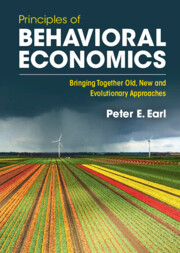Book contents
- Principles of Behavioral Economics
- Principles of Behavioral Economics
- Copyright page
- Contents
- Figures
- Tables
- Preface
- Acknowledgments
- 1 What Is Behavioral Economics?
- 2 What Motivates Us?
- 3 Why Is Life So Full of Problems for Us to Try to Solve?
- 4 How Do We Acknowledge Problems and Assess Options?
- 5 How Do We Deal with Uncertainty and Ambiguity?
- 6 How Do We Search for Solutions to Problems?
- 7 Why Do Some Things Matter More Than Others?
- 8 How Do We Choose?
- 9 How Can Firms and Governments Influence Our Choices?
- 10 What Determines the Productivity of an Organization?
- 11 How Does the Competitive Process Work?
- 12 Are There Any Behavioral Insights for Macroeconomists?
- 13 Can We Be Happy without Destroying the Environment?
- References
- Index
6 - How Do We Search for Solutions to Problems?
Published online by Cambridge University Press: 18 October 2022
- Principles of Behavioral Economics
- Principles of Behavioral Economics
- Copyright page
- Contents
- Figures
- Tables
- Preface
- Acknowledgments
- 1 What Is Behavioral Economics?
- 2 What Motivates Us?
- 3 Why Is Life So Full of Problems for Us to Try to Solve?
- 4 How Do We Acknowledge Problems and Assess Options?
- 5 How Do We Deal with Uncertainty and Ambiguity?
- 6 How Do We Search for Solutions to Problems?
- 7 Why Do Some Things Matter More Than Others?
- 8 How Do We Choose?
- 9 How Can Firms and Governments Influence Our Choices?
- 10 What Determines the Productivity of an Organization?
- 11 How Does the Competitive Process Work?
- 12 Are There Any Behavioral Insights for Macroeconomists?
- 13 Can We Be Happy without Destroying the Environment?
- References
- Index
Summary
Search for solution to problems inherently entails a problem of allocating attention in the face of uncertainty. It therefore requires the use of aspiration-based satisficing or other (dysfunctional or fast-and-frugal) heuristics and stopping rules to close off open-ended choice problems. In discussing the orthodox notion of optimal search, we end up concluding that it is logically deficient if applied to open-ended problems. Moreover, heuristic-based methods may be more effective means than lengthy deliberation for gathering information on which to base decisions – though it is shown how using heuristics can sometimes prove to be a dysfunctional way of navigating complex information environments. These issues are explored especially in relation to the challenges of choosing mobile (cell) phone connection contracts, filling job vacancies and finding marriage partners, with a focus on what is “procedurally rational,” i.e., contextually appropriate deliberation. The chapter’s analysis of shortcut search methods includes the role of market institutions, goodwill relationships and creative thinking, along with the use of heuristics for dealing with source credibility issues.
Keywords
- Type
- Chapter
- Information
- Principles of Behavioral EconomicsBringing Together Old, New and Evolutionary Approaches, pp. 146 - 178Publisher: Cambridge University PressPrint publication year: 2022

